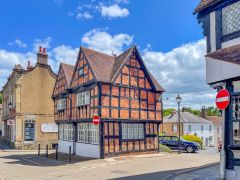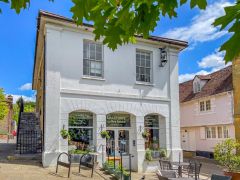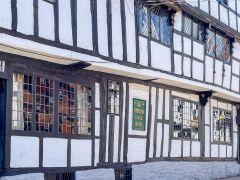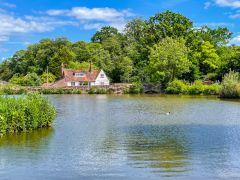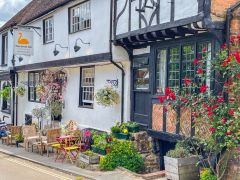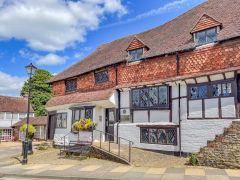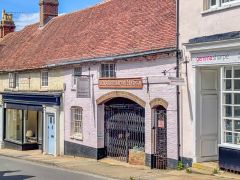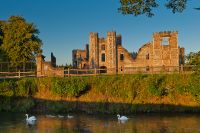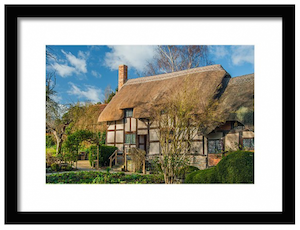
Midhurst is a picturesque market town on the River Rother, 12 miles north of Chichester. The historic core of Midhurst, known as the 'Old Town', boasts a remarkable number of listed buildings, many of them dating to the medieval and Tudor periods.
History
Shortly after William the Conqueror's invasion of 1066, the Norman lord Savaric Fitzcane built a motte and bailey castle atop St Ann's Hill, and the current town grew up around the castle fortifications.
Around the year 1300, the manor was in the hands of the powerful de Bohun family, who built a new house by the riverside. This house became known as Cowdray House, from the word 'coudrier', or hazel thicket.
Cowdray
Cowdray House today is a magnificent Tudor manor set in parkland on level ground beside the river. Though gutted by fire in 1793, the house is a marvellous reminder of a bygone age and remains one of the most imposing Tudor houses in the country, with its walls still standing to full height.
Cowdray Park is well known for its annual polo matches, which take place from April to July.

Midhurst Castle
Midhurst Castle was begun in the years following the Battle of Hastings, as Norman lords like Fitzcane sought to establish control over their new territory. The castle consisted of a timber palisade enclosing a motte and bailey fortification. Sometime around 1160 the timber defences were rebuilt in stone and in 1185 the castle was granted to Frank de Bohun, a powerful Norman lord.
The castle was abandoned around the year 1280 when a palatial new house was built on the plain below the hill. This residence grew in time to become Cowdray House.
The castle was pulled down around 1284 on the orders of Anthony Beck, Bishop of Durham, though the chapel, dedicated to St Anne, continued to serve as a place of worship for the townsfolk of Midhurst. The chapel's days were numbered, however, and it too was abandoned in turn and the present parish church became the town's religious focal point.
Excavations in the early 20th century identified parts of the castle foundation walls. These were built up to create the low walls we see today, outlining major parts of the castle layout, including a tower, chapel, hall, kitchen, and curtain wall.

St Mary Magdalene and St Denys Church
Midhurst's parish church dates to the early 13th century, though only the base of the tower remains from that period. It was heavily rebuilt in 1422 with aisles added in the 16th century. The plainly carved font dates to the 1200s, with a 17th-century wooden cover.
Other highlights include an Elizabethan pulpit and a wooden chest that may date to the 13th century. The royal coat of arms date to the reign of Queen Anne.
South Pond
You wouldn't usually think of a pond as being of historical interest, but in this case you'd be wrong. South Pond was built as a fish pond for Midhurst Castle, to provide the castle inhabitants with a supply of fresh fish. The pond was created sometime around 1150 and a water mill, now vanished, stood beneath the weir by 1284. Today, the pond and its surroundings are a public park, with trails wandering through stands of willow, alder, and cypress trees.

Historical Buildings
Perhaps the most photographed historical building in Midhurst is the timber-framed Old Market Hall, now used as an annex by the neighbouring Spread Eagle Inn. This picturesque jettied building probably dates to the 16th century and was, for a time, home to the Midhurst Grammar School.
As for the Spread Eagle, it is even earlier, with the oldest part of the building complex dating to around 1430. It was once owned by Henry VIII's Lord High Admiral and was later visited by another admiral, this tie Admiral Lord Nelson.
The writer Hillaire Belloc called the Spread Eagle 'that oldest and most revered of all the prime inns of this world'.
The 16th-century Old Town Hall (not to be confused with the Old Market Hall!) stands in Town Square, beside the parish church. Tucked into a barred opening on one side of the building are the old wooden stocks and pillory, once used to mete harsh justice on local wrongdoers.
Further down Church Hill is the Old Library, which now serves as the town hall. The first written record of the Old Library comes from 1602, but it is probably older. Across from the Old Library, at the extremity of Knockhundred Row, is the Curfew Garden, now derelict but once a 1/4 acre garden established by a medieval merchant in thanks for the Midhurst curfew bell after its sound guided him to safety when he was lost at night.

Midhurst Museum
Situated on Knockhundred Row, a stone's throw from the Old Library, is this delightful little museum of local life, crammed into a space just 8'6" square, making it perhaps the smallest museum in England. Because the space is so limited, the museum displays are rotated regularly, so there's always something new to see.
HG Wells
The most famous resident of Midhurst was probably novelist HG Wells, who attended the grammar school, and later returned to teach there. Wells set his story 'The Invisible Man' in Midhurst, and used the town as a setting for several of his short stories.
Visiting
Midhurst stands at the junction of the A272 from Petersfield and the A286, which runs between Haslemere and Chichester. As of this writing, there are three public car parks in Midhurst, with the largest being outside the leisure centre off Bepton Road. All three give easy access on foot to the historic core of Midhurst, but the leisure centre car park has the added advantage of looking down on South Pond.
Midhurst is a delight to explore. Its mix of beautiful period buildings is second to none. Our family has visited several times and we're looking forward to the next time!
About Midhurst
Address: Midhurst,
West Sussex,
England
Attraction Type: Town
Location: At the junction of the A272 and the A286, 12 miles north of Chichester. There are three paid parking areas in the town centre.
Location map
OS: SU 8901 2119
Photo Credit: David Ross and Britain Express
HERITAGE
 We've 'tagged' this attraction information to help you find related historic attractions and learn more about major time periods mentioned.
We've 'tagged' this attraction information to help you find related historic attractions and learn more about major time periods mentioned.
Historic Time Periods:
Find other attractions tagged with:
13th century (Time Period) - 15th century (Time Period) - 16th century (Time Period) - 17th century (Time Period) - castle (Architecture) - Elizabethan (Architecture) - Henry VIII (Person) - Medieval (Time Period) - motte and bailey (Historical Reference) - Norman (Architecture) - Queen Anne (Person) - Tudor (Time Period) - William the Conqueror (Person) -
NEARBY HISTORIC ATTRACTIONS
Heritage Rated from 1- 5 (low to exceptional) on historic interest
Cowdray House - 0.3 miles (Historic House) ![]()
Selham, St James Church - 2.6 miles (Historic Church) ![]()
Chithurst, St Mary's Church - 3.2 miles (Historic Church) ![]()
Trotton, St George Church - 3.5 miles (Historic Church) ![]()
Petworth House - 5.3 miles (Historic House) ![]()
Petworth, St Mary's Church - 5.4 miles (Historic Church) ![]()
Weald and Downland Living Museum - 5.4 miles (Museum) ![]()
Petworth Cottage Museum - 5.4 miles (Museum) ![]()
